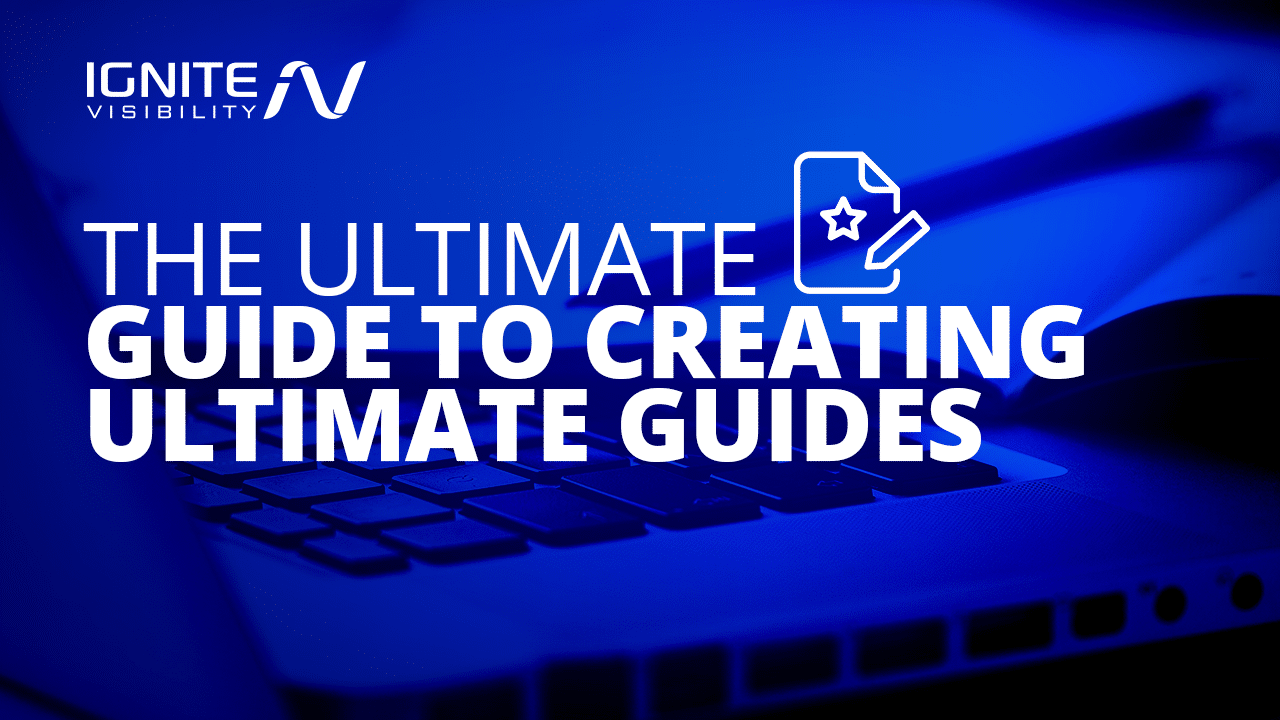
“Ultimate guide” has almost lost its meaning. Every blog with a 500-word post about a topic wants to call it “The Ultimate Guide to XYZ.”
So in this tutorial, you’ll learn how to create a guide that lives up to its name. You’ll learn what ultimate guides are, their importance, and how to build one that brings establishes you as an authority.
What is an Ultimate Guide?
An ultimate guide is a long-form resource offering exhaustive coverage of a topic. It’s often thousands of words long, breaking down complex topics into chapters.
Topics like:
- Email marketing
- Copywriting
- Content strategy
- Italian cooking
- Car detailing
- Influencer marketing
- And any other detailed subject
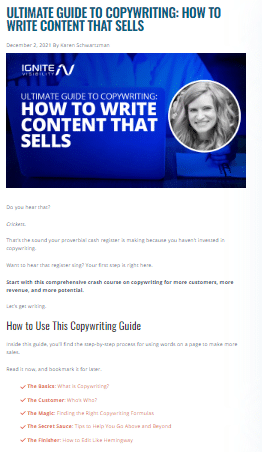
Creating ultimate guides is often necessary when targeting broad, competitive keywords. Full coverage is the only way to satisfy searcher intent for in-depth subjects.
For instance, Google’s first page for “SEO” is packed with all-inclusive guides:

They rank high because they tell users everything they need to know about SEO. People searching that term want more details than a brief summary can provide.
But being big isn’t the point of an ultimate guide.
They’re lengthy to cover the topic fully, not to meet a word count quota. A value-packed guide with 2,500 words always outranks a 5,000-word fluff piece.
Why You Should Create Ultimate Guides
Ultimate guides provide detailed coverage of a subject. This is useful for:
- Thought leadership. Posting high-quality guides positions you as an authority in your niche. At Ignite, our guides showcase our marketing expertise for prospects.
- Search rankings. Ultimate guides fulfill Skyscraper Technique—the notion that creating the best content for a keyword is key to ranking for it. So by offering comprehensive resources, you’ll earn higher placements in search results.
- Backlink building. As your guide ranks on Google, it will naturally earn backlinks from other sites referencing it after finding it useful.
- Internal linking. Ultimate guides cover many subtopics worthy of their own posts. After writing them, you can link to those posts from your master guide.
Although it’s time-consuming, every guide you post has a potentially huge ROI. Just be patient—these benefits can take months or years to take effect.
How to Build an Ultimate Guide
Making an ultimate guide isn’t simple. It means offering the most comprehensive, accurate, and up-to-date resource on a subject there is.
It’s not about the length—it’s about the value. So next, you’ll learn how to create an “ultimate guide” surpassing all others in quality.
Step 1: Create for Your Niche
Before creating your guide, consider the niche you want to build authority in. For instance, a link-building guide builds SEO authority, and a baking guide builds authority for cooking.
Creating a guide always has the byproduct of building topical authority, no matter your direct objectives.
So create a guide relevant to your brand’s focus. If you’re a marketing agency, you won’t publish a how-to guide for cleaning minivans.
Step 2: Understand Your Purpose
What do you want your guide to accomplish besides ranking on Google? Do you want to:
- Create email subscribers?
- Build topical/brand authority?
- Sell an online course?
- Create leads?
- Make affiliate commissions?
Knowing your purpose helps you write with conversions in mind.
Say you’re trying to sell an online course on the same topic as your guide. You would mention your course occasionally throughout the content, such as “If you’re interested in learning more about [topic], check out our online course.”
You’ll also be able to measure your guide’s success by your purpose. If you’re trying to build leads, and your guide generates form fill-outs, you know it’s working.
Step 3: Find Keyword(s) to Target
An ultimate guide isn’t necessarily the best way to target every keyword.
For example, a guide targeting “baseball bats” wouldn’t be effective since it’s a transactional keyword. We know this because only ecommerce listings appear for that term.

You should only create guides for keywords signaling in-depth informational intent. In other words, when someone searches for that term, they obviously want an in-depth explanation of that topic.
Examples of keywords with in-depth informational intent include:
- “SEO”
- “How does the American government work?”
- “Rules of soccer”
- “How to start a lemonade stand”
To be clear: informational intent doesn’t always mean the user wants a detailed guide. To illustrate, which of these best indicates the user wants an in-depth explanation?
- “Best places to visit in Iceland”
- “How to move to Iceland”
The answer is #2 since moving abroad is a complex process. “Best places to visit” only needs a brief overview—not a how-to guide.
You can verify a keyword’s intent by seeing what kinds of articles rank for it—just like we did with “baseball bats” above. The more competitive a term is the more accurate the results measure intent.
How to Find Keywords
A keyword research tool helps you find valuable keywords to target for guides. They tell you search volume, competition, and other information about each keyword.
Below is a search for “SEO guide” using Keywords Everywhere. It displays trend data, ranking difficulty, related keywords, and competition for your term.

Ahrefs—another keyword tool—performs a similar function.
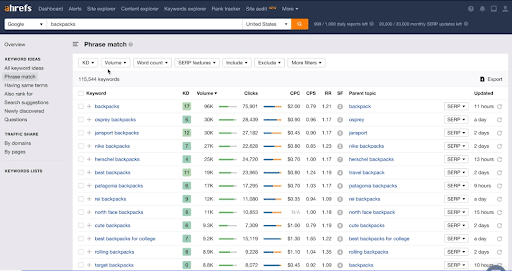
Use these tools to scope out the ideas you already have in mind.
Say you wanted to write an ultimate marketing guide but found it too competitive to rank for. So instead, you create a guide on influencer marketing.
Step 4: Examine Competitors
Next, check out competing guides for your target keyword. You need to study each detail of their guides—noting the things they’re including and omitting.
- How long are their guides?
- Does each sentence provide value, or is it a fluff piece?
- How many images and graphics do they feature?
- Do they feature unique insight or just regurgitate other guides?
Their guide is probably high quality if they’re ranking for your target keyword. But even the best guides will fall short in some areas (depth, graphics, unique data, etc.).
Remember: your goal is to create the best resource on the subject available (that’s what makes it “ultimate”).
So imitate what they’re doing well, and fill the gaps where they fall short. That’s the Google Plugin Strategy, and it’s a recipe for consistent SEO success.
Step 5: Understand Your Audience
Your guide isn’t for you—it’s for an audience. Naturally, you’ll need to understand what they want.
Start by searching Reddit and Quora for discussions about your guide’s topic.
These two sites are ground-central for consumer discussion without the contamination of promotional material (affiliate links, paid content, etc.). It’s just ordinary people seeking information.
Next, survey your audience. You can do this by sending survey emails or asking questions on social media.
Ask them questions like:
- “What’s your biggest insight into [topic]?”
- “What’s your biggest struggle with [topic]?”
- “What’s one thing about [topic] you wish other people knew?”
- “What’s your biggest question about [topic]?”
- “What’s one part of [topic] you wish more resources existed for?”
Direct feedback from your audience eliminates guesswork from your content strategy. It makes your guides more useful and far likelier to meet your goals.
Step 6: Compile Data
Facts tell, but stories sell. Examples, statistics, and case studies should support each claim your guide makes.
This fulfills EAT—Expertise, Authoritativeness, and Trustworthiness. EAT is the standard Google uses to judge a page’s usefulness to searchers.

You build trust with readers by including sources to support your claims. It shows you know what you’re talking about, which translates to authority.
This authority makes you an expert fulfills EAT requirements.
How to Find Reliable Sources
Sadly, finding reputable sources to include in your guide isn’t as easy as it should be.
A search for “[topic] statistics” usually yields poorly cited articles. There may be references of references (of references), outdated data, or no citations at all.
Your citations should point to recent, reputable sources. Here’s how to find data meeting that criteria:
- Company studies/reports. Companies like HubSpot and McKinsey regularly publish studies of their industries. They’re always sources of well-researched, in-depth information.
- Content from reputable sources. A reputable publisher like AP or SEJ always cites sources correctly. It’s easy to find good data by searching their content library for articles about your subject.
- PrimoStats. PrimoStats is a SaaS providing quality statistics across a wide range of industries.
Building trust with your audience requires correct citations of reputable sources. Trust in your guide plummets if readers notice your citations are incorrect or outdated.
Step 7: Build Your Guide
With your foundation set, it’s now time to build your ultimate guide.
Your mission is to turn the data gathered into the best guide available for your target keyword. It satisfies audience needs and provides unique, actionable insight to help them reach their goals.
Write for a Specific Outcome
A reader of any ultimate guide is looking for a specific result.
Someone reading “The Ultimate Guide to Moving to Thailand” wants to know how to move to Thailand from beginning to end. So the entire text should focus on achieving that goal, discussing things like:
- Thai culture
- Visa requirements
- Weather
- How to move internationally
- Best places to live
- Pet safety
- And everything else you’ll need for moving to Thailand
Lastly, end with an actionable CTA that moves the reader towards your main goal. For example:
- “Hire [company] for marketing excellence” (building leads)
- “Start optimizing your website now” (thought leadership)
- “Download our SEO checklist” (email list building)
Include Third-Party Resources Where Needed
Ultimate guides aren’t just about what’s on the page, but what further resources you can recommend. Going back to the moving to Thailand example, you should also link to:
- Embassy pages
- Moving consultants
- Travel agencies
- And any other resources the reader will find useful
Sending users to other websites may seem strange, but the best guide is the one that helps them achieve their goals, and third-party content can be essential to that.
Just make sure all your links open in a new tab so users stay on your page.
Include Visuals
Visuals help communicate ideas effectively. In particular, infographics are excellent at simplifying complex concepts.
Below is an infographic featured in our Amazon FBA article. This helps users understand exactly how FBA works in a quick and easy-to-read way.
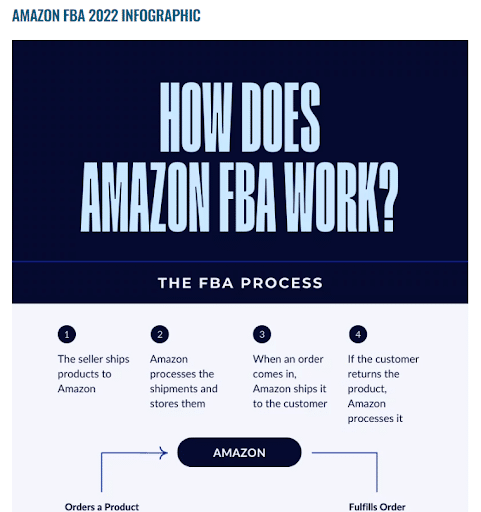
Effective visuals also make your content seem more polished.
Your guide’s custom visuals show readers you’ve spent time and effort putting it together. This boosts your credibility, further fulfilling EAT.
Lastly, quality visuals are sharable. When people study your guide, they’ll share the graphics providing those “a-ha!” moments by translating complex topics into digestible information.
Offer Content Upgrades
A content upgrade is a bonus you give your readers in exchange for their contact info. These transform your ultimate guide into a lead-gen machine, harnessing its traffic fully.
Examples of content upgrades include:
- Multi-day email courses
- Ebooks
- Product discounts
- Reading material related to the guide’s topic
- Content templates (email, marketing, content calendar, etc.)
You can plug content upgrades anywhere within your guide. Below, HubSpot plugs their SEO starter pack at the end of their guide:
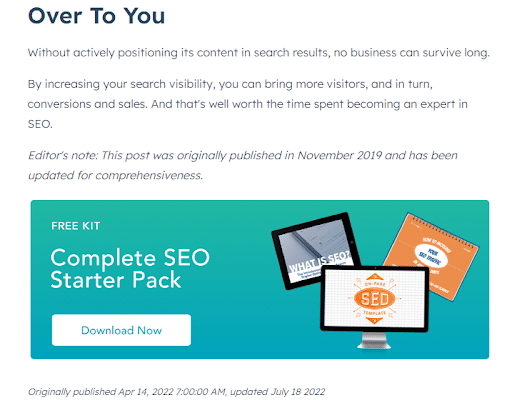
8. Promote Your Guide
The moment you hit “publish” on your ultimate guide is just the beginning. Next, you need to get as many eyes on it as possible.
Several proven strategies can help you achieve that:
Build Backlinks
Quality content is the key to building traffic, but backlinks (links from other sites) help accelerate the process. A backlink acts as an endorsement from the referring site to Google’s ranking engine.
You can build backlinks with:
- Guest posting. Write free posts for other blogs, and link your guide within the content. Make sure the link is “do-follow” so it passes on authority.
- Direct requests. Write to other sites and ask them to link to your guide. Because this form of link building is saturated, you’ll need to explain why it will help their readers have a chance at a “yes.” If you make custom graphics for your guide, ask them to link to them specifically for best results.
- Social sharing. By sharing your guide on social media, you expose it to other publishers. They’ll naturally link to your guide in their content if they find it useful.
Promote on Social Media
Social media is the first place to feature your guide. It’s simple, quick, and your followers see it immediately.
Just make sure to add context to your link.
Engage the user’s interest with an engaging hook and discuss a common issue. You can then plug your guide as an answer, as Ahrefs does below:
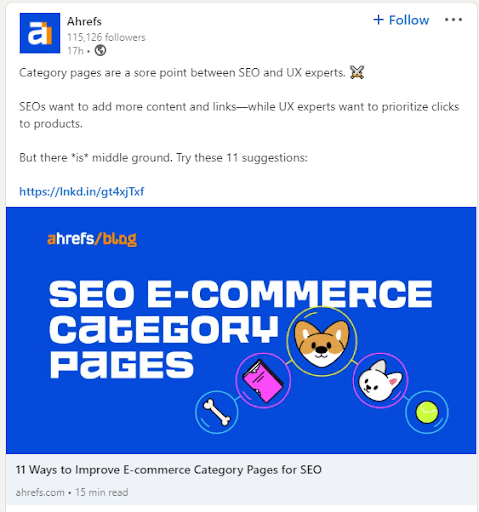
Run PPC Campaigns
Running PPC campaigns for a guide might seem confusing at first. Isn’t that usually reserved for landing pages, which lead directly to sales?
Not exactly. If your guide drives the reader towards a specific action, it can be just as lucrative as any landing page.
For example, Semrush is an SEO SaaS running PPC ads for the keyword “SEO guide.”
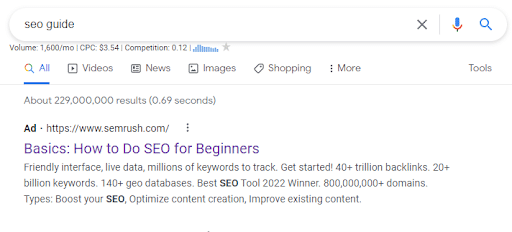
They subtly plug their SaaS into their blog content, generating countless leads over time.
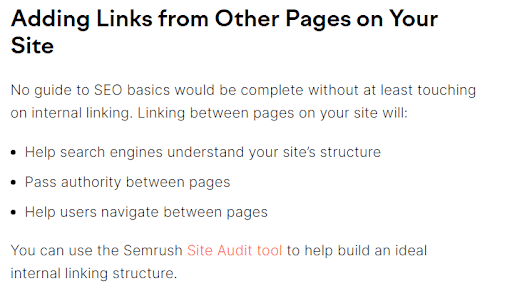
If enough visitors translate to subscriptions, the small amount paid for each click yields a massive ROI.
Plus, running PPC ads for your blog isn’t just useful for lead generation. It’s also a clever way to build backlinks (people read the blog and naturally link to it) and brand awareness/thought leadership.
9. Maintain Its Content
An ultimate guide—or any other web content—is never truly complete. It should always be a living, breathing knowledge base updated regularly.
This is “content maintenance,” and it’s just as important as creating new content. If you don’t update your guide over time—adding new information, updating old stats, optimizing certain bits—it will become obsolete and sink in rankings.
Plus, Google tends to rank updated content over obsolete competitors. Maintenance isn’t just good for user experience, it’s vital for SEO.
Bonus: Repurpose Your Content
Your guide won’t be able to explain every topic fully. Otherwise, it would be 10,000s of words long and unreadable for people looking for a quick overview.
Instead, break down each topic into separate articles. This does two things:
- Provides further reading for those who want to learn more about specific topics
- Expands your overall content coverage
You can also break down pieces of your guide into social posts, ebooks, and email campaigns.
For instance, let’s say you create an ultimate guide to SEO.
You can then choose a part of it—say, link building—and use the same research you’ve already done to create five social posts. Now you have material for multiple quality posts for barely any additional effort.
Start Creating Your Ultimate Guide
You’re reading an ultimate guide right now. Notice how we’ve thoroughly explained each topic, gradually equipping you with everything you need to create your guide.
As you can see, creating an ultimate guide is more than slapping “ultimate” on a how-to guide and calling it a day. It’s creating an exhaustive resource, answering every question the user could have.
Making one takes tons of research, writing, graphic design, and polishing. But when finished, you’ll have an asset generating tons of traffic and leads for your business.